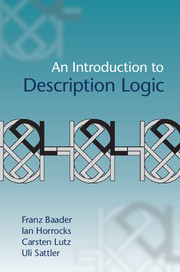Book contents
- Frontmatter
- Contents
- 1 Introduction
- 2 A Basic Description Logic
- 3 A Little Bit of Model Theory
- 4 Reasoning in DLs with Tableau Algorithms
- 5 Complexity
- 6 Reasoning in the EL Family of Description Logics
- 7 QueryAnswering
- 8 Ontology Languages and Applications
- Appendix Description Logic Terminology
- References
- Index
8 - Ontology Languages and Applications
Published online by Cambridge University Press: 13 June 2017
- Frontmatter
- Contents
- 1 Introduction
- 2 A Basic Description Logic
- 3 A Little Bit of Model Theory
- 4 Reasoning in DLs with Tableau Algorithms
- 5 Complexity
- 6 Reasoning in the EL Family of Description Logics
- 7 QueryAnswering
- 8 Ontology Languages and Applications
- Appendix Description Logic Terminology
- References
- Index
Summary
As discussed in Section 1.2, DL systems have been used in a range of application domains, including configuration, software information and documentation systems and databases, where they have been used to support schema design, schema and data integration, and query answering. More recently, DLs have played a central role in the semantic web [Hor08], having been adopted as the basis for ontology languages such as OIL, DAML+OIL and OWL [HPSvH03]. This has rapidly become the most prominent application of DLs, and DL knowledge bases are now often referred to as ontologies.
In computer science, an ontology is a conceptual model specified using some ontology language; this idea was succinctly captured by Gruber in his definition of an ontology as “an explicit specification of a conceptualisation” [Gru93]. Early ontology languages were often based on frames, but as in the case of early DLs, a desire to provide them with precise semantics and well-defined reasoning procedures increasingly led to ontology languages becoming logic-based. The OIL ontology language was something of a compromise: it had a frame-based syntax, but complemented this with a formal semantics based on a mapping to SHIQ. In DAML+OIL and OWL the DL-based semantics were retained, but the frame-based syntax of OIL was replaced with a structure much closer to DL-style axioms.
In Section 8.1 we will discuss OWL in more detail, examining its relationship to RDF and to SROIQ, its syntax (or rather syntaxes), some features that go beyond what is typically found in a DL, and its various profiles or sub-languages. In Section 8.2 we will look at some interesting examples of OWL tools and applications.
The OWL ontology language
OWL is a semantic web ontology language developed by the World Wide Web Consortium (W3C), an international community that defines Web technologies. W3C follows a consensus-driven process for the publication of specification documents for Web technologies, in particular Recommendations, which are considered Web standards. OWL was first standardised in 2004, and then revised in 2012, with the revision being denoted OWL 2. Although using a variety of more “Web-friendly” syntaxes based, e.g., on XML and RDF, the basic structure of OWL corresponds closely with that of a DL, and includes such familiar constructs as existential and value restrictions, (qualified) number restrictions, inverse roles, nominals and role hierarchies (see Chapter 2).
- Type
- Chapter
- Information
- An Introduction to Description Logic , pp. 205 - 227Publisher: Cambridge University PressPrint publication year: 2017
- 1
- Cited by



